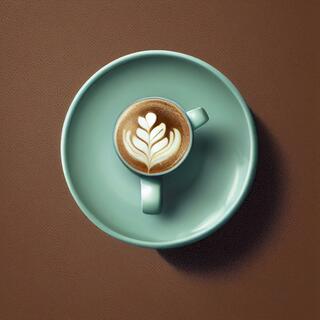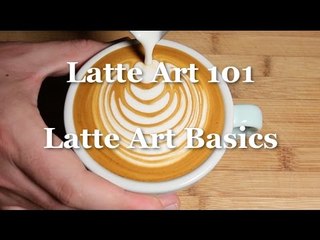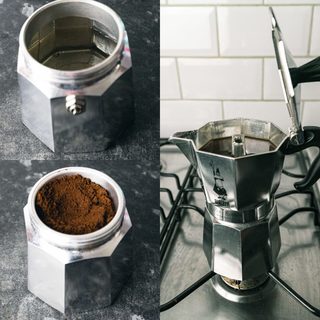Caffeinated Canvases: Unleashing the Magic of Coffee and Latte Art
Coffee is a beverage that I adore; in fact you can almost guarantee that when I am writing these posts, I will have a hot cup of black coffee beside me. So why would I want to write about it on my blog you ask? Well I believe that making coffee properly is also an art, having had many good and bad coffees over the years leads me to believe that a good barista is like a good artist and vice versa.
click on this image for a youtube tutorial to learn some basic latte art
One of my pet hates when ordering the style of coffee I like is that there doesn’t seem to be a standard version and each café or coffee makes it completely different. I like to drink my coffee black, I like it diluted with some hot water as I don’t like it really really strong and I like it in a standard sized cup so I can spend some time drinking it. What I normally order is an Americano, as that’s what they’re called in the bigger cities, well at most good coffee s anyway, but back here at home I usually need to describe exactly what it is or I end up with a half a cup of coffee in a miniature cup that Im sure are only served to children and goblins as they’re so tiny, a jug of boiling hot water beside it if Im lucky enough (God knows where Im supposed to put it as the cups so damn small!) and get this, a jug of milk as well; even if I have explained that its supposed to be just black! Other times it comes out in a fishing boat sized vessel with a mere puddle of inky black coffee in the base and the jug of hot water, or worse yet they have topped it up for me and it ends up a case of ‘smells like coffee but can’t taste any’ its so diluted!
What I don’t get is why the massive variations, it seems anything from a flat white (Coffee with milk isn’t it?) through to a short black can be passed off as an Americano. I also plan to one day ask at a local establishment if they can show me the difference between a short black, a long black and an Americano because when I get takeout coffee from them, its ALWAYS a half filled cup of black coffee….what the hell is that all about?
So what is coffee? Coffee is a brewed drink prepared from roasted seeds as in coffee beans, which come from the coffee plant. The seeds come from coffee cherries that grow on trees in over 70 countries throughout the world. Green (unroasted) coffee is one of the most traded agricultural commodities in the world. Due to its caffeine content, coffee can have a stimulating effect in humans. Today, coffee is one of the most popular beverages worldwide. Coffee berries, which contain the coffee seed, or "bean", are produced by several species of small evergreen bush of the genus Coffea. Once ripe, coffee berries are picked, processed, and dried. The seeds are then roasted to varying degrees, depending on the desired flavour. They are then ground and brewed to create coffee.
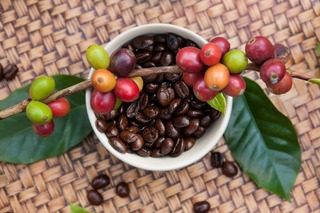
Coffee berries and their seeds undergo several processes before they become the familiar roasted coffee. The coffee berries are picked and sorted by ripeness and colour. The flesh of the berry is removed by machine, and the seeds or beans as they are better known, are fermented to remove the slimy layer of mucilage still present on the bean. Sounds an awful lot like wine at this stage! After fermentation and washing, the seeds are dried. The next step in the process is the roasting of the green coffee. The roasting process influences the taste of the beverage by changing the coffee bean both physically and chemically. The bean decreases in weight as moisture is lost and increases in volume, causing it to become less dense. The density of the bean also influences the strength of the coffee and requirements for packaging. The actual roasting begins when the temperature inside the bean reaches approximately 200 °C (392 °F), During roasting, caramelisation occurs as intense heat breaks down the starches in the bean, changing them to simple sugars that begin to brown, which change the colour of the bean. Sucrose is rapidly lost during the roasting process and may disappear entirely in darker roasts. During roasting, aromatic oils, acids, and caffeine weaken, changing the flavour; at 205 °C (401 °F), other oils start to develop. One of these oils is caffeol, created at about 200 °C (392 °F), which is largely responsible for coffee's aroma and flavour.
Darker roasts are generally smoother because they have less fibre content and a more sugary flavour. Lighter roasts have more caffeine and a stronger flavour from aromatic oils and acids otherwise destroyed by longer roasting times. Decaffeination may also be part of the processing that coffee seeds undergo. Seeds are decaffeinated when they are still green. Many methods can remove caffeine from coffee, but all involve soaking the green beans in hot water or steaming them, then using a solvent to dissolve caffeine-containing oils.
Once roasted, coffee beans need to be stored properly to preserve the fresh taste of the bean. Ideally, the container must be airtight and kept in a cool, dry & dark place. In order of importance: air, moisture, heat, and light are the environmental factors responsible for deteriorating the flavour in coffee beans. The foil folded-over bags which contain a one-way valve, that prevents air from entering and allows you to remove air trapped inside after you seal it, is the best way to store your coffee at home.
Coffee beans must be ground and brewed to create the drinkable coffee. Almost all methods of preparing coffee require the beans to be ground and mixed with hot water for long enough to extract the flavour, but without boiling for more than an instant; as boiling develops an unpleasant ‘cooked’ or as my dear friend Sheryl calls it ‘burnt’ flavour. The spent grounds are removed from the liquid, and the liquid is ready to drink. There are many variations in the fineness of grind, with Turkish being the finest or French the coarsest; the ways in which the water extracts the flavour, additional flavourings like sugar, milk, spices or syrups, and the removal of the spent grounds. The ideal holding temperature is 79 to 85 °C (174 to 185 °F) and the ideal serving temperature is 68 to 79 °C (154 to 174 °F). A lot of coffee s would do well to check the temperatures of their coffee as this is so important to getting it right.
At home we can use machines like coffee percolators and automatic coffeemakers to brew or coffee. This method uses gravity to brew the coffee. In an automatic coffeemaker hot water drips onto coffee grounds which are held in a coffee filter made of paper, plastic, or perforated metal, this allows the water to seep through the ground coffee while extracting its oils and essences. The liquid drips through the coffee and the filter into a carafe or pot, and the spent grounds are retained in the filter. In a percolator, boiling water is forced into a chamber above a filter by steam pressure created by boiling. The water then seeps through the grounds, and the process is repeated until you remove it from the heat, or it switches off by an internal timer or by a thermostat that turns off the heater when the entire pot reaches a certain temperature.
Once brewed, coffee can be presented in a variety of ways. Drip-brewed, percolated, or French-pressed/cafetière coffee may be served with a dairy product such as milk or cream, or dairy substitute, or as is which is just black coffee. It may be sweetened with sugar or artificial sweetener. Or served cold as iced coffee.
Click on the image to learn how to use a coffee percolator
Now baristas who don’t know their cappuccinos from their flat whites or short from long blacks, pay attention here, espresso-based coffee has a wide variety of possible presentations. In its most basic form, it is served alone as a shot or in the more watered-down style as in my ‘Americano’ which is a shot or two of espresso with hot water added. Reversing the process by adding espresso to hot water preserves the crema, and is known as a long black, they are not the same thing ok! Milk can be added in various forms to espresso: steamed milk makes a café latte, while equal parts steamed milk and milk froth makes a cappuccino, and a dollop of hot foamed milk on top creates a café macchiato. A dollop of cream on a shot of black coffee is a
Now for the arty bit; Latte Art where the barista creates a pattern or design on the surface of the coffee using a mixture of two elements, the crema, which is an emulsion of coffee oil and brewed coffee, and the micro foam, or the air in milk. Neither of these colloids are stable as the crema dissipates from espresso, while the micro foam separates into drier foam and returns to liquid as in back to just milk – both degrading significantly on the order of minutes, so sadly the latte art lasts only briefly.
Latte art can also be created or embellished by simply “drawing” in the top layer of foam; it is particularly difficult to create consistently, due to the demanding conditions required of both the espresso shot and milk. This, in turn, is limited by the experience of the barista and quality of the espresso machine. The pour itself, then, becomes the last challenge for the latte artist.
This style of coffee art was developed independently in different countries, following the introduction of espresso and the development of micro foam, the combination of crema and micro foam allowing the pattern; it presumably was initially developed in
So how do you make it? Before the milk is added, the espresso shot must have a creamy brown surface, an emulsion known as crema. As the white foam from the milk rises to meet the red/brown surface of the shot, you create a contrast and the design emerges. As the milk is poured, the foam separates from the liquid and rises to the top. If the milk and espresso shot are “just right,” and the pitcher is moved during the pour, the foam will rise to create a pattern on the surface. Alternatively, a pattern may be etched with a stick after the milk has been poured, rather than during the pour.
The two most common forms of poured latte art are a heart shape and the ‘Rosetta’ or ‘rosette’, also known as the ‘fern’ which resembles a type of flower or fern leaf. Of these, hearts are simpler and more common in macchiatos, while rosettes are more complex and more common in lattes.
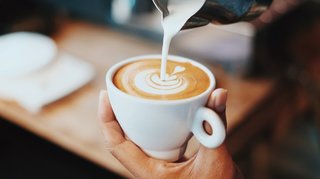
For free pouring, the cup is either kept level or tilted in one direction. As the milk is poured straight into the cup, the foam begins to surface on one side (due to the tilt). The barista then moves the pitcher from side to side as they level the cup, or simply wiggle the spout back and forth, and finishes by making a quick strike through the previously poured pattern. This "strike" creates the stem portion of the flower design, and bends the poured zigzag into a flower shape.
A more direct pour and less wiggling yields a heart shape, and minor variation with reduced lobes and a larger stem, this creates more of an apple shape. You can create more complex patterns, of which some require multiple pours to a single cup. Then there is Etching. Etched patterns range from simple geometric shapes to complicated drawings, such as crosshatched patterns, animals, and flowers, and are generally performed with a coffee stirrer of some sort.
Latte art is made by adding micro foam to espresso. Similar patterns, though much fainter, can be achieved by adding micro foam to brewed coffee, as in a café au lait. Alternatively, patterns can be etched in the crema of an espresso, without adding any milk, so we then have something different as in its now called espresso art, and it means people like me who drink black coffee and enjoy art don’t have to miss out on the fun!
Some controversy exists within the coffee community as to whether or not there is excessive focus on latte art amongst baristas. The argument is that too much focus on the superficial appearance of a drink leads some to ignore more important aspects such as taste. Let’s hope they get it together and we can enjoy both all the time.
Posted: Thursday 29 April 2010
